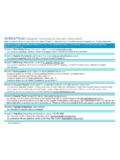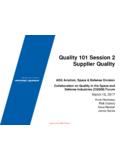Transcription of SUPPLY CHAIN MANAGEMENT Seven Steps To …
1 Seven Steps ToMeasure SupplierPerformanceby Sherry Gordon20 IAUGUST organization knows it should beassessing supplier performance . Most aredeploying some sort of supplier perfor-mance measurement, whether it is a couple of rudi-mentary key performance indicators (KPIs) ormore sophisticated data gathering and on-siteassessment programs. But few purchasing andquality professionals are likely to answer yes when asked whether they are satisfied with theirsupplier assessment capabilities and results. With increased reliance on suppliers for one sown ability to meet customer requirements andexpectations, and even, in some cases, to complywith legal and regulatory requirements, organiza-tions are under increasing pressure to avoid sup-plier problems and to attract and retain the highperformers, particularly among their strategic sup-pliers or long-term can an organization turn thought into actionand effectively use internal resources to improve theperformance of these key suppliers and, at the sametime, produce results and a return on investment?
2 The following Seven Steps comprise a process fordeveloping and deploying supplier assessment:1. Align supplier performance goals with organi-zational goals and Determine an evaluation Develop a method to collect informationabout Design and develop a robust assessment Deploy a supplier performance Give feedback to suppliers on their Produce results from measuring supplier CHAIN MANAGEMENT In 50 WordsOr Less Understanding supplier performance is a given intoday s business environment. Paying attention to performance both preventsproblems and promotes improvement. Seven Steps to focusing on strategic and long-termsuppliers can produce meaningful results andreturn on Align performance Goals Determining what performance your organiza-tion wants from its SUPPLY CHAIN cannot be done ina vacuum. You must first have in place a supplierstrategy that relates to overall organizational goalsand objectives. Many organizations are pursuing continuousimprovement programs and methodologies suchas Six Sigma, lean enterprise, lean sigma, continu-ous improvement, operational excellence and totalquality MANAGEMENT .
3 Typically, organizations try-ing to get to the next level of excellence need tohave key suppliers aligned with their own organi-zational direction. If a company is pursuing lean and just-in-timedeliveries, key suppliers need to be on a lean jour-ney themselves, because the lack of synchronizationcan adversely impact cost, quality and delivery. If acompany is committed to Six Sigma and has devel-oped a fact based culture, then the company willrequire a similar approach to performance improve-ment from its important , if a company has not articulatedan enterprise improvement strategy, the drive toallocate the resources to measure and improve sup-plier performance will be less strong. It is difficultto ask suppliers to do what I say and not what Ido. Additionally, commitment of resources fromupper MANAGEMENT to such a program may be dif-ficult if continuous improvement is not valuedwithin the Choose Evaluation ApproachThe aspects of supplier performance that compa-nies may wish to evaluate include: Financial health.
4 Operational performance metrics. Business processes and practices. Enabling behaviors or cultural factors. Risk health is most impor-tant for key suppliers or long-term partners. Typicalindicators of financial strength include factors suchas sales, profitability and liquidity. Financial datacan be obtained via Dun & Bradstreet or other cred-it reports, banks and trade references. Data are, of course, more accessible for publiclytraded companies than for privately held ones. So,sometimes the best way to get financial informationis to ask suppliers directly. The challenge lies in being able to spot negativetrends in advance of a major problem. It is not nec-essary to rely solely on financial reporting tools,because an understanding of a supplier s opera-tional performance metrics and business processesand practices can reveal potential financial performance metrics can cover many areas, such ason-time delivery, quality, lead times, responsive-ness (rescheduling, order status), inventory turnsand customer service call response time.
5 There are several ways to obtain these metrics:extract them from your own enterprise system,QUALITY PROGRESSIAUGUST 2005I21 Why Measure SupplierPerformance?An enterprise should measure supplier performance because: You can t manage what you don t measure. If you measure suppliers, they will improve. You can uncover and remove hidden waste and cost drivers in the SUPPLY CHAIN . You can facilitate supplier performance improvement. You can increase competitiveness by shrinking order cycle times and inventory levels. You can make informed business decisions that impact the reports from the supplier or conduct internalsupplier satisfaction surveys of the end user at thecustomer. Business processes and and practices can be reviewed to see howa supplier runs its business and provides a productor service at the best value, on time and exactly asrequired for its customers. This information is typi-cally best practice based and qualitative, focusedon processes and inherently independent of anyvertical business sector bias.
6 Business processes and practices information canbe obtained through questionnaires or surveys orduring site visits to suppliers. This information iscritical for creating and maintaining mutually ben-eficial long-term relationships. It is also some of themost resource intense information to obtain, bothfor the customer and the supplier . Organizations should consider applying com-mercially available supplier assessment softwaretools for this purpose to scale the process. Evaluating business processes and practices canhelp get at the root causes of supplier problems. Tra-ditional quantitative metrics can highlight a problemor negative trend but cannot get at the root cause. A supplier , for example, may make a productthat meets quality standards but do this by inspect-ing quality into the product rather than throughdefect prevention methods. This can result in even-tual degradation of quality, with the product hav-ing a poorer cost structure to support inspection. In the case of a service business, a company mayneed to add resources to maintain adequate servicelevels because of the inefficiency of its behaviors or cultural factors.
7 At theheart of high performance business models such asSix Sigma, the Malcolm Baldrige National QualityAward criteria and lean are enabling behaviors, suchas customer focus, agility, continuous improvementand teamwork. If, for example, a supplier does not have a continu-ous improvement culture, it is unlikely that supplierwill be in sync with the demands of a customer thatvalues continuous improvement methodologies andexpects the same drive to improve in its SUPPLY base. Risk factors. An important aspect of evaluatingsuppliers is to understand and then mitigate can uncover risk factors in financial health,operational performance environment, businessprocesses and practices, and enabling behaviors orcultural factors. Risk cannot be determined solelyby using past performance to predict the future. Financial risk factors may be the most obviousarea many companies focus on. The operationalperformance environment includes risk from deal-ing with foreign suppliers, such as trade relations,shipping and currency exchange.
8 The business processes and practices a supplierhas in place are also critical. For example, knowingwhat processes a supplier uses (if any) to, in turn,manage its suppliers helps identify risk in lowertiers of the SUPPLY base not visible to the customerorganization. Another risk factor is the leadership in place at asupplier. A leadership committed to investing inthe workforce and enabling employee empower-ment and input has a greater chance of success andovercoming business adversity as it arises. A cul-ture lacking teamwork and continuous improve-ment indicates higher risk to the customer, as thechances of a supplier being responsive to systemicproblems and getting to root causes of problemsand correcting them are slimmer. SUPPLY CHAIN MANAGEMENTS upplier Information OutputsFIGURE 1 Internal feedback surveysSupplier assessmentsImported dataPerformance metrics (KPIs)ScorecardsOverall performanceQUALITY PROGRESSIAUGUST 2005I233. Develop Information Collection MethodThe challenge is the coverage problem how tocollect any of the above information for a large por-tion of your SUPPLY base using current include paper questionnaires, web basedquestionnaires, extracts from current systems, sitevisits and third-party standard certification.
9 Thesemethods and their associated challenges are shownin Table thinks he or she can write a question-naire, but most questionnaires, in fact, are poorly con-structed. They are typically vague, full of buzzwords,ask for several pieces of information in one questionand are discouragingly too long. They are just plaindifficult to fill out easily and quickly. In addition, theinformation gathered often is not actionable. If the assessment system design is not optimal,it will then be difficult to collect the drawback to questionnaire based supplierdata gathering is that too few data points are gath-ered from too few people, and the validity may bequestionable. Quality managers, site managers orowners typically complete supplier surveys, and ifthey don t get others inputs, they simply tend topaint a rosy picture of their own business. Outputs of the various methods are shown inFigure 1 and can include: Reporting on survey results. supplier performance metrics such as KPIsderived from internal surveys or internalmanagement systems.
10 supplier assessment reporting, which can bequalitative and quantitative. Ultimately and ideally, supplier performancescorecards containing a rollup or summaryview of all should create a holistic view of sup-plier performance , expose it to internal supplierrelationship managers and give suppliers access totheir performance indicators for increased Design a Robust Assessment SystemOrganizations need to choose an approachto evaluating suppliers. Approaches mayinclude: Accepting a third-party standard, suchas ISO 9001 and its sector specificderivatives or good manufacturingpractices. Benchmarking performance againstindustry leaders. Measuring performance against bestpractices, such as the Malcolm BaldrigeNational Quality Award criteria. Developing KPIs and scorecards basedon system data or internal customerfeedback. Developing your own certification orevaluation and measuring performanceagainst matter which components of a suppli-er assessment system an organization devel-ops, a big challenge lies in creating a systemfounded on metrics both relevant to thebusiness and based on generally acceptedbest practices.







